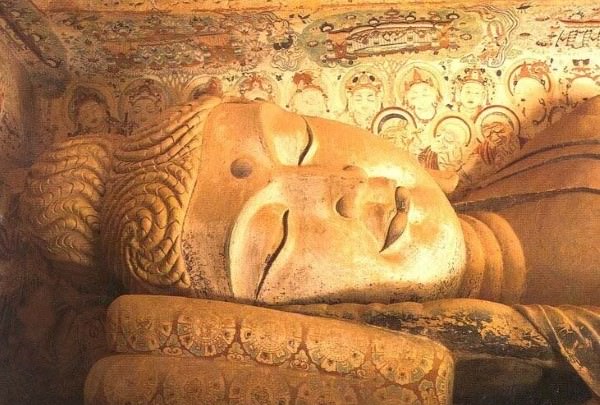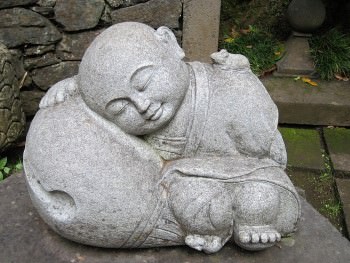6 Yoga Nidra Scripts for Sleep and Deep Relaxation

Yoga Nidra is literally 'sleep yoga' in Hindi. It's a mental exercise that takes place in the mysterious borderland state between wakefulness and sleep. By maintaining awareness as you relax and your body starts to fall asleep, you can enter a profound state of consciousness – with potentially profound psychological, spiritual and physical benefits.
To some then, Yoga Nidra might bear a striking resemblance to a Wake Initiated Lucid Dream. After all, Yoga Nidra visualizations take place in the colorful land of hypnagogia.
But Yoga Nidra practitioners are not typically lucid dreamers. A lucid dreamer will use the hypnagogic state as a springboard to dream control, whereas non-lucid dreamers use a Yoga Nidra script to hang out there and spend time meditating as a means of achieving deep relaxation and promoting self-love, emotional release, and gratitude.
In this article, we'll take a look at the history of Yoga Nidra, how to prepare for it - and finish up with some simple Yoga Nidra scripts you can try out for yourself.
Yoga Nidra History

Sadly, Yoga Nidra has had a pock marked history in the last few decades, after the term was popularised by disgraced cult leader Swami Satyananda in 1970s.
Thankfully the true history of Yoga Nidra has its roots far deeper in the past!
It's mentioned in various texts as far back as 300 BC. It is however not until the 12th century or so that the term was used in a way that corresponds to its current meaning.
Here is a nice description from the Yogatārāvalī (24-26), a 13-14th century yoga text:
“This extraordinary sleep of no slothfulness […] manifests for people when all their former attachments have vanished because of the superiority of their inward awareness. Having mastered cessation of the mind while sleeping, […] O friend, forever enter that special thoughtless sleep which consists of only consciousness."
So - for at least 800 years - “Yoga Nidra” has referred to the unique state of consciousness that occurs just before the body prepares to enter sleep paralysis.
It is worth noting that traditionally Yoga Nidra was not used to help sleep, for deep relaxation or for self-improvement (like we do today) but as a catalyst of achieving 'samadhi' a thoughtless state similar to nirvana or enlightenment in Buddhist philosophy.
If you're the type who likes to delve deeper, there's a wonderful article on the history of Yoga Nidra here.
The Difference Between Yoga Nidra and Lucid Dreaming
I'll make this nice and simple (is anything ever, really).
The answer to what is the difference between Yoga Nidra and lucid dreaming is a matter of extent.
- Yoga Nidra practitioners establish awareness during a half-asleep, half-awake state and stay there – deeply relaxed - meditating and visualising, to achieve specific benefits or outcomes.
- Lucid Dreamers establish awareness during a half-asleep, half-awake state and then carry forward that consciousness into dreams, for the purpose of controlling those dreams.
One could therefore say that Yoga Nidra is excellent practice for those attempting to learn the WILD method of lucid dream induction.
What is a Yoga Nidra Script? I'd Like Guided Instructions!
If you're a beginner, this probably all sounds great – but you'd no doubt be on the lookout for some guided Yoga Nidra instructions.
These guided instructions take the form of 'scripts' which can be easily downloaded and followed.
It's worth noting that the use of the word 'script' here is actually a bit of a misnomer.
This all started back in 1976 when Swami Satyananda wrote in his book that the best way to learn Yoga Nidra was from listening to (buying) one of his tape recordings. This has since been discredited, along with his entire body of work.
After all, people have been practicing sleep meditation and dream yoga for countless centuries, way before tape recorders were invented!

At its core, Yoga Nidra is actually extremely simple.
It amounts to an initial phase of mental preparation, which takes 5-10 minutes and is identical to widely used modern mindfulness techniques.
What then follows is a specific visualization. This is tailored to the intent of the session – be it falling asleep, deep relaxation, self-improvement, psychological enquiry, healing from trauma or something else.
A superior approach is to use flexible high level visualizations that provoke the necessary emotions and feelings – but allows your own subconscious the freedom to fill in the gaps.
So it may be more accurate to call these Yoga Nidra 'visualizations' instead of 'scripts'!
Aim for each session to last around 20 minutes.
That's 5-10 minutes for the preparation and 10-15 minutes for the visualization. You can repeat each visualization several times, if you find it is over too quickly. Don't rush.
Practice when you go to bed at night, in the dark.
(or, if you're after a daytime nap - you might lay down on the floor in the savasana pose)
Yoga Nidra Preparation

The preparation is the same for all the visualizations.
You can also use it to prepare for your own personal visualizations (feel free to devise your own - there's no such thing as a 'sacred' script. The more personal the symbolism, the better).
Lay back in your bed and close your eyes.
It is possible to do Yoga Nidra on your side, but not recommended - your back is the best position.
Relax your body and mind as much as you can.
Your goal is to remain still for the next 20 minutes or so. If you feel an itch or compulsion to move, try to re-focus on your practice - each time you move will set you back a little.
The first goal of the preparation is to re-unite with your body.
During our hectic modern lives we enjoy very cerebral pursuits…
It's all too common for us to get “up in our heads”.
Swirling thoughts, anxiety and stress. This can be controlled and soothed by re-connecting with our bodies. Direct your awareness to your body. Part by part.
Start with your neck and shoulders. How do they feel? Sense the tension in your muscles and allow it to dissipate. You may be surprised at how much tension you are holding, without being aware!
Then move to your back and do the same thing. Next your face, your arms and your legs.
If you find this enjoyable, you may wish to extend it even further with the 61 Point Relaxation Technique.
When you have finished scanning your body and are fully aware of it, it's time to shine the light of our awareness inwards - to our emotions and thoughts.
The second goal of the preparation is to re-unite with your mind.
Allow yourself to recognise any major emotional or life events that are occurring at the moment.
There's bound to be something, right… even if it's just feeling wound up at your boss after a long day at work.
We're often taught that meditation is about 'emptying your mind'.
Not so.
Don't feel guilty for having thoughts!
Mindfulness is more about how you react to your thoughts.
We are not trying to drain our thoughts away, like water out of a bath tub. We are merely allowing ourselves to recognise our thoughts and emotions without becoming attached to them. We are accepting them, casually observing them - and allowing them to pass, without focusing on them.

Imagine yourself sitting on a rock by the side of a flowing stream, looking down into the waters. You are the observer.
The water is your thoughts and emotions.
Allow it to flow past you. Remain present and aware of – but not attached to – thoughts that pass through your mind.
OK. So we've mindfully re-connected with our body, our thoughts and emotions.
Now it's time to bring ourselves fully into the present by re-focusing awareness on our breath.
The third goal of the preparation is to be mindful of the present moment.
Breathe naturally. Calmly.
Allow each breath to slowly take its course.
Focus your awareness on these breaths, feel every detail of them. One by one.
Where is it in your body? How does it feel? Is it a long breath or a short breath? You may never have considered any of these questions before. But every single breath is as intricately and subtly different as the grains of sand on a beach.
Each grain of sand comes from a different rock or perhaps a shell that was once a living creature swimming in the ocean. These details are often overlooked. Just as every breath is different!

Our breath changes according to our emotional state, heart rate, excitement and stress levels. Feel it flowing over every single millimetre of your wind pipe.
Truly appreciate each one.
Count the breaths. From 1 to 10.
Focus only on the breath. Allow any thoughts that intrude to flow away like water in the flowing stream.
You may be surprised how hard it is to simply count from 1 to 10 without an external thought intruding! Do not feel bad, this is quite normal.
Do this 3 times, for a total of 30 breaths.
You should now be in a calm, relaxed and 'half-asleep' state. Your mind is alert, but your body is deeply relaxed and preparing for sleep.
You are now ready to commence your Yoga Nidra visualizations.
Just be careful not to actually fall asleep (unless of course, you are doing Yoga Nidra for sleep and that is your goal. Doh!)
Script 1 – For Sleep or Insomnia

You are laid on your back on a water lily, floating on top of a vast motionless ocean in a faraway land. The water is completely still and you feel completely safe and at peace. The air is warm as you feel the steady heat of an unknown sun beat down upon your face and body – cleansing you.
You are happy and comfortable, drifting on your back - with your eyes closed, safe, cased all around by your strong, thick water lily and miles from anything but calm open water.
The strength of the water lily makes you feel protected and safe. It is thick and the water cannot even think about seeping in.
Rest here, drifting happily – without a care in the world.
As you drift, content, warm, safe and protected – your awareness begins to fade away and you drift off to sleep.
Script 2 – Deep Relaxation

Your mind feels like the sky.
Each cloud is one of your thoughts or emotions. Take a moment to look up at your sky and see which of the themes in your life are up there. Which are looming dark rain clouds and which are little white puffs skiting briskly across the sky.
Most beautiful of all is the bright, brilliant, beaming patches of clear blue. You focus on these and feel the weight lift from your shoulders. You breathe deeply and feel yourself relax.
Slowly, all the clouds in the sky are one by one blown away by a brisk wind imbued with an enchanting energy.
You watch the clouds disappear over the horizon and as you do your mind clears. You feel a great sense of relief and deep relaxation.
Only blissful, clear, open blue is in your mind now.
Your mind seems now blank as a white piece of paper.
Script 3 - Self Love, Self Respect and Self Confidence

You see a great, wide, tall sunflower in front of you. Behind it, is a golden glowing field of wheat. The sunflower rises up, gloriously, full of light and energy. In the middle of the sunflower is a baby. Young, pure and innocent. Just days old, wrapped, tightly.
You feel a strong, intense, giving love towards the baby. It is all that is good about humanity.
You feel how much the baby is worth.
You feel, deeply in your heart, how much the baby deserves love.
The baby is you.
You feel your feet connected to the Earth, wholesome energy flowing through you. You raise up your arms to the sky. The energy and life-force of the baby joins with yours and flows up through you and into the sky.
Script 4 – Emotional Release and Healing

You are on a high cliff top, sparse vegetation and dry dirt around you, surrounded by a vast expansive open sky.
You have a small iron cauldron in front of you.
As you stand, you are filling the cauldron with pieces of you. From inside your heart.
The pain, the fear, the hate, the tears, the anger, the sorrow. Whatever your troubles are.
All of it is taken from your body and you feel it leaving you as it enters the cauldron.
You pick up the cauldron by its handle, with both hands, and swing it around your body. You feel the muscles of your back arch and the toes of your feet dig into the ground as you fling the cauldron over the side of the cliff with all of your might.
You let out an almighty yell as the liquid that was in the cauldron disperses and separates into ten million tiny droplets that spread far far out into the sky slowly until they are completely gone.
You feel a sensation of weight lifted from your heart. You feel light and happy.
You smile as suddenly you are under a waterfall and the water hammers down upon you, cleaning you inside and filling up your heart with joy.
Script 5 – Gratitude

Imagine yourself sat high above the world on a silver platform, looking down upon the Earth.
You feel your heart grow with thankfulness for everything you have.
You imagine the food you have and think carefully about where it came from and the energy of the people who had to work to produce it.
You imagine the comforts you have – running water, heat, shelter, electricity. Friends, family. Your health. The Internet. Your heart grows bigger.
You say slowly thank you for everything you have. Think of every little thing.
A network of silver lines connects you from your platform to every other living person on the planet. It is infinitely complex. You feel your heart grow larger still. Love and karma spread from you along these silver links and you feel it flow across your body and into the collective heart of humanity.
Script 6 – Success and Achievement

You are a wanderer, alone, trekking across a vast continent. Grass grows to either side.
You feel the heavy backpack upon your shoulders.
The weight feels difficult on your hips and your legs as you trudge onwards.
You continue endlessly. Your heart beating steadily. It dips not once.
As you continue walking, days and nights pass, seasons come and go. Winter passes. Summer comes. Through light, through dark, you march.
Rains come and go. The sun scorches you. Insects bite you.
Still you march. Still you continue. You age. Years. You have been walking for ten years.
Eventually the walk ends and you feel a deep, deep joy slowly surge throughout your whole being and settle in your heart.
Finally you have done it and you feel faith, contentment and satisfaction in your heart.
Final Thoughts
Well, that's it! I hope you enjoyed these Yoga Nidra scripts...
The mind truly is opened up in a profound way during these wonderful night time meditations.
If you agree, think about learning how to lucid dream – it's only 10 steps more along the same path!















